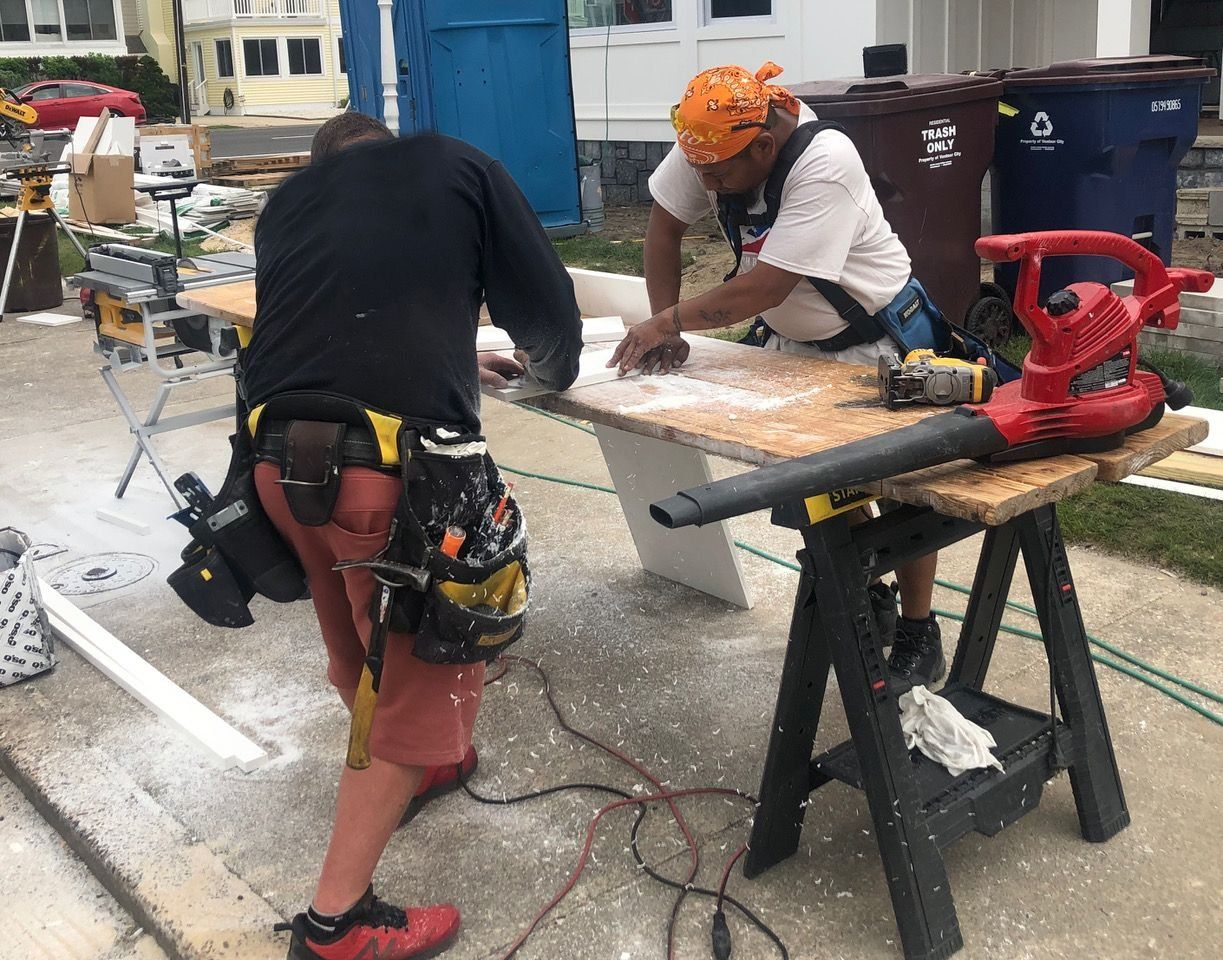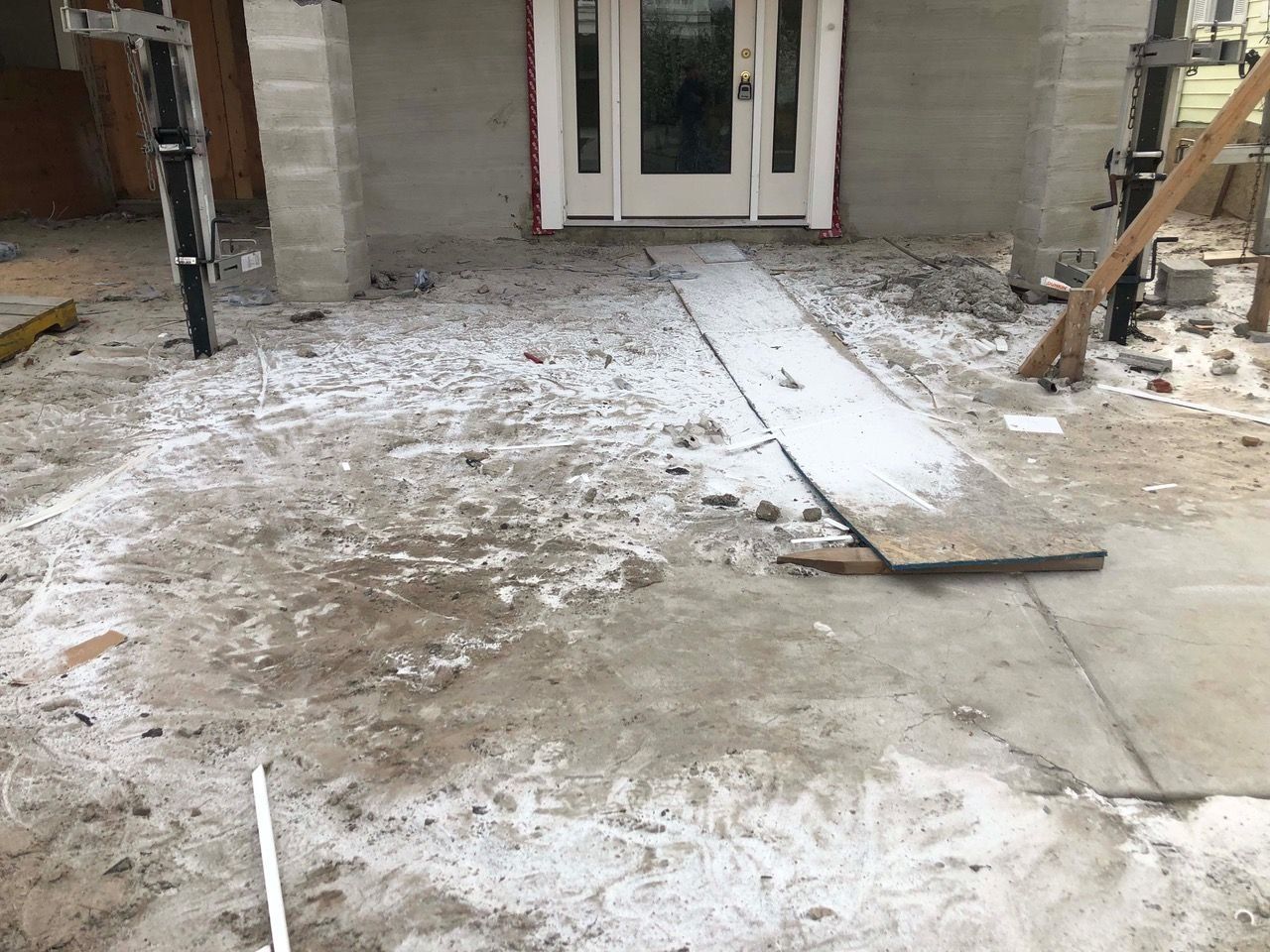
About a year ago, while scrolling on Facebook, retired NBC reporter Brian Thompson saw something that shook him. A woman named Sherri Lilienfield shared photos of her front lawn covered in at least two inches of what, at first glance, looked like pristine white snow. It was not. It was plastic dust from a nearby construction site, where workers had been cutting up plastic building materials out in the open.
“It’s always windy here,” Lilienfield said about Margate, a 1.6-square-mile town on the Jersey Shore about a 20-minute drive south of Atlantic City. “Stuff blows everywhere.”
Lilienfield, who has a background in chemical engineering and has been a real estate agent since the 1990s, was worried. She knew that construction on the Jersey Shore was booming and that plastics are increasingly replacing traditional construction materials like wood, stone, and concrete, especially near the shore, where people want to use maintenance-free materials. She also knew researchers have been sounding the alarm about these plastic materials, as they might have potential adverse health outcomes.
As part of the local advocacy group Sustainable Margate, Lilienfield began distributing flyers that alerted workers to potential health hazards at construction sites. But she quickly realized that “this needs to come from the top, right? Because contractors, they’re just like, ‘Why are you complicating my life?’” So the group drafted an ordinance requiring contractors to contain pollution from cutting plastic and other materials.
It was around this time when Thompson, who lives in the nearby town of Monmouth Beach and is a member of his town’s Environmental Commission and an advisory board member for Beyond Plastics NJ, found Lilienfield’s post on Facebook. He asked for a copy of the ordinance, and started working to get a similar one passed in Monmouth Beach.
Now, Margate and Monmouth Beach are just two of 16 towns along the Jersey Shore which have passed ordinances addressing microplastic pollution from construction sites. A coalition of grassroots organizations, including Beyond Plastics NJ, Clean Ocean Action, Sustainable Haus Mercantile, Save Barnegat Bay, and the Surfrider Foundation, is pushing to pass similar ordinances in another dozen towns as well as a statewide law.
The approved and proposed ordinances prohibit contractors from blowing debris, dust, or plastic contaminants into streets or storm drains, and requires contractors to use tarps, saw hoods, and vacuum attachments to contain plastic sawdust. In total, contractors need to invest around $500 in reusable equipment, but they also see a reduction in cleanup costs, Lilinfield said. The simplicity and cost-effectiveness of the measure, Thompson explained, helped them to easily gain the support of contractors across towns, helping the mandates to pass swiftly.
“We’re not necessarily saying, ‘don’t use this and use this instead,’ CeCe Carter, mid-Atlantic regional manager for the Surfrider Foundation, one of the organizations promoting the bills, told EHN. “But what we are saying is that there should be very simple regulations in place to … ensure the safety of workers and people, neighboring communities, and the environment.”
According to Erica Cirino, communications manager at the advocacy group Plastic Pollution Coalition, the new legislation is among the first to address plastic waste in construction sites. “It’s really one of the only things I’ve seen recently looking to specifically control plastic building material pollution,” Cirino told EHN.
However, some researchers and advocates believe that this approach only tackles one small part of the full scope of construction’s plastic pollution problem, which has been largely overlooked.
“People don’t even know how much of the built environment is plastic — but our paints are plastic, water pipes are plastics, most carpets are plastic,” Teresa McGrath, the chief research officer for Habitable, a research and advocacy organization, told EHN.
As a result, construction has become a big consumer of the plastic produced globally. Habitable estimates that building and construction account for 17% of total plastic production worldwide, making the industry the second highest-use sector for plastics, only surpassed by packaging. Construction is among the largest consumers of certain plastic materials, accounting for 70% of all Polyvinyl chloride, or PVC, produced in 2019 and for 30% of total polystyrene use in the same year.
“These ordinances are for protecting the neighbors and the communities. But they really don’t address the full life cycle of plastics used in construction,” Cirino said. Most experts agree a better way to address the problem would be to start at the source and encourage or require the use of non-plastic materials whenever possible.
A polluting lifecycle

Addressing the full scope of pollution from plastics in construction will require taking into account the full life cycles of the materials, McGrath said. “From fossil fuel extraction, through manufacturing, installation, use, and disposal,” a 2024 Habitable policy brief says, building materials linked to the plastic industry create pollution that “harms communities, workers, building occupants, and the environment.”
Plastic production emits significant amounts of greenhouse gases, exacerbating climate change. A 2019 report noted that at current levels, the industry’s emissions “threaten the ability of the global community to keep the global temperature rise below 1.5°C,” the level scientists say will limit the most severe impacts of climate change on humans and ecosystems.
Additionally, producing some of the construction industry’s most widely used plastic materials requires the use of potentially harmful substances, such as vinyl chloride and styrene, both known carcinogens, which are used to manufacture PVC and polystyrene. Manufacturers add a wide array of chemicals to plastics to give them specific characteristics, like durability or flexibility, which may have potential health impacts. Research has shown that PVC and polystyrene building materials can contain chemicals like phthalates, organotins, or flame retardants, which have been linked to health impacts like developmental issues, behavioral disorders, endocrine disruption, and reproductive problems, among others.
“It’s really critical,” Surfrider Foundation’s Carter said. “The people cutting the materials themselves are immediately at risk. They’re bending over the table saws and breathing this plastic in. People in the neighborhood [are at risk] too.”
Lilienfield particularly worried when this microplastic dust fell on her neighbor’s vegetable garden.
During its active lifecycle, plastic in construction materials can leach chemicals. There’s evidence of indoor microplastic pollution, but research has not yet shown how much of it is coming from construction materials — like paint slowly chipping away or carpeting shedding fibers — and our understanding of exactly how this type of pollution could potentially harm human health is still in its early stages.
These materials harm the environment once homes are torn down or remodelled. The end of life for vinyl, for example, is “either landfill or burning,” McGrath explained. Landfills’ environmental impacts are well established, and burning releases dioxins, which have been linked to reproductive and developmental problems, immune system problems, impaired hormone function, and some types of cancer.
Other materials end up polluting the environment. Every year, Americans discard 1.2 million tons of carpeting — most of it made from plastic fibers — and reports have found that paint is increasingly flowing into oceans. While figures vary widely, recent modelling from the environmental group Earth Action suggests that about half of all microplastics in oceans and waterways are estimated to come from paint (though researchers are still working to understand how much of it comes from boats, vehicles, and buildings).
To mitigate these impacts, some producers have proposed using recycled plastic materials in construction — but the impacts of this strategy could be similar to those of brand-new products.
“Plastic is harming everyone all along its endless existence,” Cirino said.
Compliance alliances

McGrath said that while the Jersey Shore ordinances are a good start, more is needed to fully address plastic pollution in construction. “Protecting those waterways and the workers and neighbors from the exposure is super important,” she said. “But you’re still using polystyrene, and you still have those life cycle impacts — the upstream impacts that happened before that product ever got to the Jersey Shore and the downstream impacts when that house is renovated or knocked down to build the next thing.”
A more comprehensive approach, she argues, would be to create incentives to use alternative materials. These incentives could look like relaxing requirements when using safer materials, limiting the use of certain materials when designing building safety codes (for example, taking into account the flammability of synthetic materials), and taking “an essential use approach,” which means that plastic materials (and other potentially harmful materials) should only be used when there are no safer alternatives and the plastic material is necessary for the products to work.
These approaches may have a harder time garnering the support of the building sector and require strong backing from city and state governments. However, they can still be successful, McGrath said. There are pilot affordable housing projects in California, New York, and Washington that use safer materials. Minnesota’s housing finance agency launched an incentive system to encourage projects to phase out potentially harmful materials in affordable housing.
So far, the New Jersey coalition has not considered introducing these more comprehensive measures into their ordinances. Their next step is trying to bring the effort to a state level, where a Margate representative has already agreed to introduce a bill to contain microplastic dust pollution across the state. “Are we gonna eliminate this problem? No,” Lilienfield admits. “But every little bit helps.”
Editor’s note: The Plastic Pollution Coalition sponsors EHN’s Plastic Pollution Newsletter.





